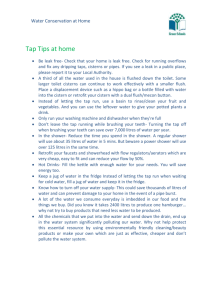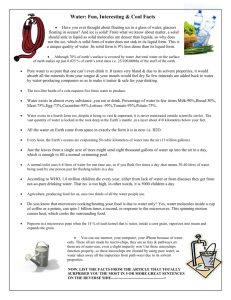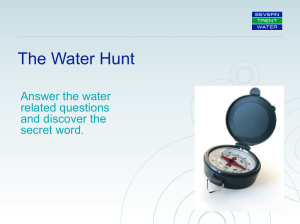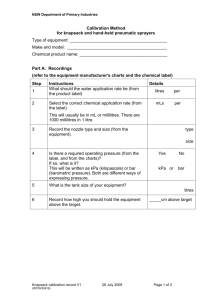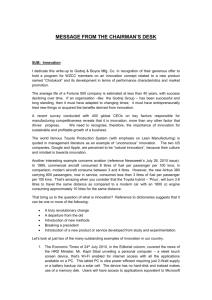Handbook SmarT Office
advertisement
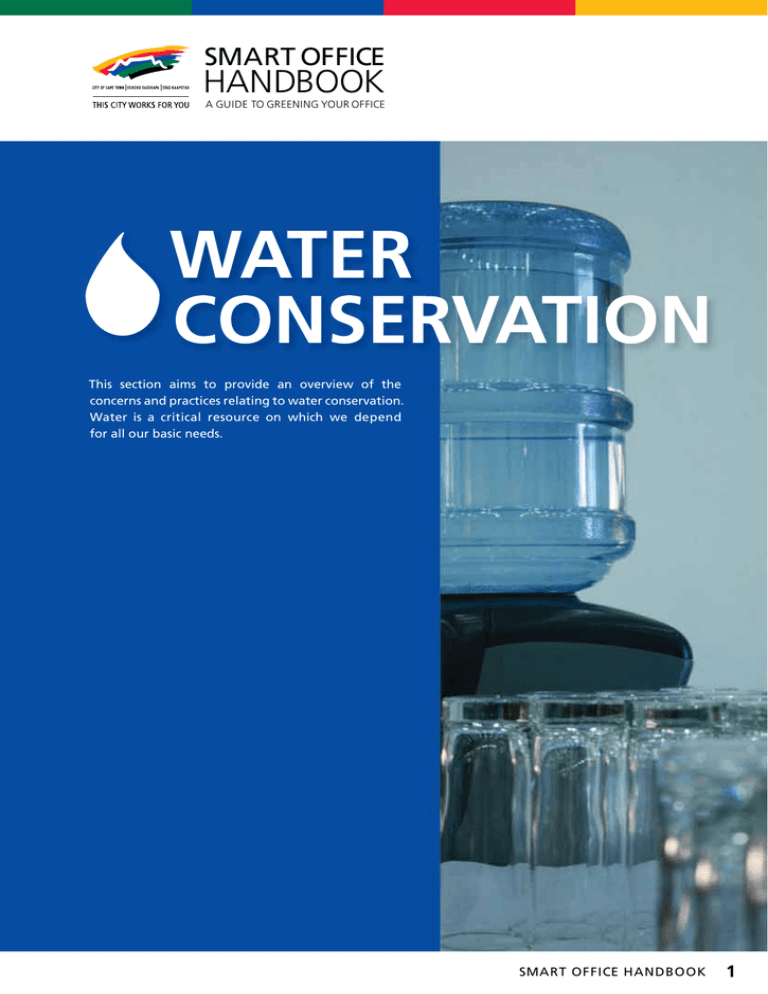
Smart Office Handbook A guide to greening your office This section aims to provide an overview of the concerns and practices relating to water conservation. Water is a critical resource on which we depend for all our basic needs. Smart Office Handbook 1 Water Demand Management The City of Cape Town encourages all residents and business to use water with care. The Water By-law (2010) stipulates that no person may negligently, purposefully or wastefully permit pipes or water fittings to leak, use water fittings that are incorrectly adjusted or inefficiently use water of allow the inefficient use of water to persist. An owner must repair or replace any part of the water installation that is wasting water. A consumer must ensure that any equipment or plant connected to the water installation uses water in an efficient manner. Any owner or consumer must comply with the good water conservation and demand management practices. Major water users (those using more than 10 000 kilolitres per annum), excluding those comprising multiple dwelling units, must undertake an annual water audit. The audit must reflect the amount of water used, the number of people working on the premises, details of initiatives to manage demand for water and comparisons over a three year period. Water conservation Water is a critical natural resource on which we all (humans, animals, plant life, sea life, etc.) depend. It is one of the most important life-support systems we have on our planet. South Africa is a water-stressed country with limited renewable water resources. We are currently using water in an unsustainable manner, and there will not be enough water supplies for everyone in the future. We are over-exploiting and polluting the resources we have. We must become aware of the impacts of our unsustainable water use, and change our behaviour. Providing fresh drinking water to a growing population is both challenging and costly. With 98% of our fresh water supplies already allocated for use, the projected water demand for South Africa is not sustainable, and we are already experiencing water shortages in some parts of the country. Currently, the only sustainable option is to implement water conservation. Water conservation is the implementation of one or several measures to reduce the amount of water used in your office, and the water used to produce the goods and services that your office uses. Implementing water conservation measures and promoting a water-wise office will have many benefits. It will result in cost-savings (cheaper water bills); make the company more competitive; reduce the company’s carbon and water footprints; and contribute to local, national and global water conservation. If you reduce your company’s water footprint, you will improve your company’s social and environmental profile and make it more competitive in an increasingly environmentally-aware market. Increasing urban development and the impacts of climate change (such as drought and floods) will make water security a priority in South Africa. Water conservation initiatives also make excellent corporate social responsibility projects. You can contact local environmental organisations and team up with other offices for ideas on projects to get involved in. Quick start The City has recently launched a ‘Keep saving water’ campaign, with tips and advice on how to save water. • Water Audit: Do a water audit to determine a few simple items that are using most of your water, and focus on how you can address these. It is important to have a baseline (starting point) so you can measure the impact of the interventions. • Strategy and action plan: Ensure that you determine your strategy with specific goals that you want to achieve, as well as an action plan on how you want to do this. Your green team should actively participate in this process to ensure success. • Maintenance: It is very important to ensure that there are no dripping taps or toilets at the office, so ensure that this area is included into a monthly maintenance check as part of your action plan. • Gardens: The watering of lawns and gardens is very water intensive, and not permitted between 10:00 and 16:00. • Awareness: Ensure that employees understand why it is important to save water, and what is expected from them. This might require an internal awareness campaign. Things to do Restroom and washing facilities • Use only non-toxic and biodegradable soaps. • Taps should be fitted with aerators, which can reduce the water flow from 20-30 litres per minute to 6-10 litres. • If your office has showers, encourage the users to close the taps while shampooing, and to only take short showers. • Fit water-efficient showerheads, which save water and energy (and money). • Install water-efficient toilet flush systems with cisterns not exceeding 9.5 litres. • If your office has a new plumbing system, make sure that the settings are correct (especially for flush-master toilets). • Ensure that any dripping taps or toilets are fixed as soon as possible. Garden or outdoor spaces • Remove alien vegetation and replace with water-wise and local indigenous plants. Alien vegetation is often very thirsty, and in South Africa this is one of the biggest threats to our fresh water supply. • Only water your outdoor office garden and office plants between 16:00 and 10:00, and avoid watering when it is very hot or windy (the water will evaporate and not be absorbed by the plants). • Install a drip irrigation system: By slowly dripping water to the roots of the plants instead of using sprinklers or a hose for watering, the water use is made more efficient and directed to the right place. Sprinklers and hoses are less precise, and often cause unnecessary run-off as the soil gets saturated. Remove alien vegetation and replace with water-wise and indigenous plants. Alien vegetation is often very thirsty, and in South Africa this is one of the biggest threats to our fresh water supply. Download Click here to download a water audit template and cheat sheet. Click here to download resources such as posters, stickers or training material. For more information, visit www.capetown.gov.za/water 2 Smart Office Handbook Smart Office Handbook 3 It takes 130 ℓ of water to make a cup of coffee. About 18 900 litres of water is needed to produce 1 kg of roasted coffee. For a standard cup of coffee, one needs about 7 g of roasted coffee, so that a cup of coffee uses about 130 litres of water. Salt water The Cape Town Water By-law requires companies that use large amounts of water to do an annual water audit. • Ensure that sprinkler systems are set and directed correctly to prevent water from running off paved areas into stormwater drains. Fresh water • Avoid hosing down hard surfaces or paved areas to prevent water from going into the stormwater drains (which basically wastes water and contributes to blocking and overflowing of the system). If it is absolutely necessary to use a hose, then try not to use drinking water, rather grey water or rain water. Accessible water • Cars should be washed on permeable surfaces where possible, to prevent wasting water and blocking or overflowing of stormwater drains. • Install rainwater tanks to harvest and store water for your office gardens, pot plants, cleaning, and flushing. • Design a roof garden with some plants and shade for staff to relax over lunchtime. • Lay permeable paving on your office property to encourage natural drainage; hard surfaces contribute to water runoff and debris overflowing and blocking stormwater drains. (look closely) Less than 3% of all the water on Earth is fresh water. Only a small portion (0,3%) of this is accessible through rivers or dams Freshwater consumption has risen at double the rate of population growth. Kitchen, canteen and catering 6 Smart Office Handbook • Avoid letting the tap run without actually using the water for anything – it sounds odd, but you’d be surprised how many people actually do this! • Only boil the amount of water you need when using the kettle – if you boil too much, keep the rest warm in a flask to be used later. • Reduce office-related water pollution to zero: Only use biodegradable cleaning products and make sure you do not dispose of hazardous waste in the sink or toilet. • Use the economy cycle on your dishwasher and washing machine. • Only run the dishwasher when full; and when rinsing glasses, do so in a bucket or plugged sink rather than under a running tap. • For cold water, keep a jug or a bottle of tap water in the fridge instead of letting the tap run to get rid of warm water (this can be reduced by insulating the pipes). • Make sure your fridge is air-cooled and not water-cooled. • Do not boil more water than is needed for cooking. • Switch from bottled water to tap water, even if you need to invest in a filter. Smart Office Handbook 7 10ℓ It takes 10 litres of water to make an A4 sheet of paper. Water footprinting The water footprint of a product is defined as the total volume of fresh water that is used directly (actual footprint) or indirectly (virtual footprint) to produce a product or service. It is estimated by considering water use in all steps of the production chain. About 18 900 litres of water are needed to produce 1 kg of roasted coffee, taking into consideration the water needed to grow the plant and the process for roasting the coffee. For a standard cup of coffee (250ml) we need seven grams of roasted coffee, so a cup of coffee needs about 130 litres of water when you consider the whole process from plantation to cup. Eskom needs about 1.35 litres of water per kWh of electricity produced. This means that Eskom uses 27 litres of water to provide you with enough energy to run one energy-efficient light bulb of 20W for an hour. Saving electricity also saves water. Here are a few examples of different products and the amount of water that they require during their manufacturing or production cycle: • • • • • 5ℓ 10 litres of water for one A4 sheet of paper 130 litres of water for one cup of coffee (250 ml) 1 700 litres of water for a slab of chocolate (100g) 2 500 litres of water for one cotton shirt (250 g) 8 000 litres of water for one pair of jeans (800 g) Your company can reduce its operational water footprint by saving water in its own operations and reducing water pollution to zero. For most businesses, however, the supply-chain water footprint is much larger than the operation footprint. It is therefore crucial that your company address that as well. Achieving improvements in the supply chain may be more difficult – because it is not under your direct control – but it may be more effective. Your company can cut its supply-chain water footprint by making supply agreements including certain standards with its suppliers, or simply by changing to another supplier. In many cases this may not be a trivial task, because the whole business model may need to be transformed in order to incorporate or better control supply chains and to make supply chains fully transparent to consumers. Among the various alternative or supplementary tools that can help improve transparency are: setting quantitative waterfootprint reduction targets, benchmarking, product labelling, certification, and water-footprint reporting. www.waterfootprint.org Smart Office Handbook 9 Reality check Water is a scarce resource, yet few people really use it consciously. We need to move beyond just closing the tap, and look at what we need to go into the tap. We need to review business practices and ensure that the most effective water-saving principles are implemented and that the staff actively participate. Resources 10 Smart Office Handbook • Click here for the water section of the Smart Living Handbook (www.capetown.gov.za/smartlivinghandbook). • Click here to download your water audit form and cheat sheet. • Click here to download stickers and posters, which you can print and use in your office to raise awareness around water saving. • Click here to download training material for your staff.

